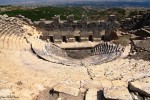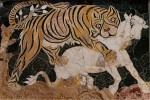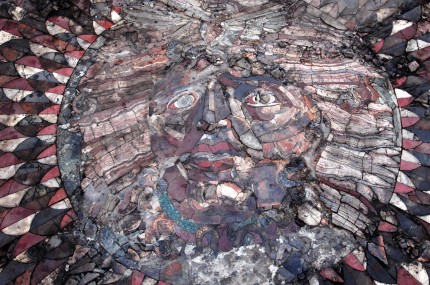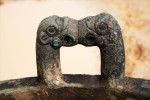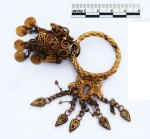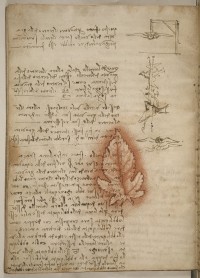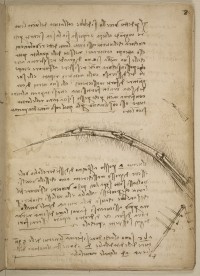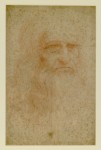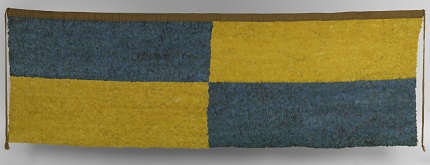
Peru; reportedly from Corral Redondo, Churunga Valley
Wari; 7th-10th century
Feathers on cotton, camelid fiber, 28 3/4 x 83 1/2 in.
The Metropolitan Museum of Art, The Michael C. Rockefeller Memorial Collection, Bequest of Nelson A. Rockefeller, 1979
Twelve massive feather panels made by the pre-Inca Wari people of Peru at least 1000 years ago and possibly as long as 1,400 years ago have gone on display at the Metropolitan Museum of Art in New York City. The panels in the Feathered Walls: Hangings from Ancient Peru exhibition, 10 of which are in the Met’s permanent collection while the remaining two are loans, will adorn the 88-foot-long wall between the ancient South American art galleries and the modern art galleries, an ideal transition for pieces of ancient Peruvian art whose solid colors and sharp geometries have such a contemporary aesthetic.
The feather panels were discovered in 1943 by workers making adobe near the town of La Victoria in the Churunga Valley along the southern coast of Peru. In an enclosure known as Corral Redondo after three concentric walls that encircles it, workers first encountered Inca artifacts and human remains before unearthing six to eight humaniform ceramic jars (conflicting reports have muddied some of the details) decorated with mythological subjects. The jars were three to four feet high and each contained 12 rolled up feathered panels for a total of 96. It was the largest discovery of ancient Peruvian featherwork ever made.
Kept safe in their jars from the depredations of insect, climate and the salty ocean air, many of the panels were found to be in excellent condition. The average size of the feather panels is seven feet in width and two feet and a half in height. They were all made using the materials and stitching method. On a foundation of plain-weave cotton, body feathers from the blue and yellow macaw were individually knotted onto strings and then stitched onto the cotton panels in overlapping horizontal rows. Along the top is a woven band made from camelid fibers with braided ties attached to the upper corners. It’s those ties that strongly suggest the panels were used as wall hangings rather than, say, garments or blankets. Hung against the rough grey walls common in Wari architecture, these brilliant, refined color blocks would have transformed a humble space into a suitable setting for ceremonial purposes.
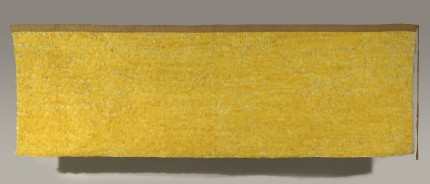
Peru; reportedly from Corral Redondo, Churunga Valley
Wari; Carbon-14 date 660-870 (95% probability)
Feathers on cotton, camelid fiber, 27 1/4 x 84 in.
The Metropolitan Museum of Art, The Michael C. Rockefeller Memorial Collection, Bequest of Nelson A. Rockefeller, 1979
Four of the panels in the Met’s collection have been radiocarbon dated to between 600 and 1000 A.D, placing them firmly in the period of Wari hegemony in south coastal and highlands Peru.
Feathers, particularly those from colorful birds, were a highly valued material in ancient Peru, and featherwork was likely one of the most treasured of Wari art forms, which also include other types of fine textiles, polychrome ceramics, exquisite personal ornaments made of precious materials, and small-scale sculpture.
Such portable luxury goods were markers of wealth and power, and because the Wari, like other ancient Andean peoples, did not use a writing system, they also played an important role in expressing, recording, and preserving concepts about the human, natural, and supernatural realms. The bold minimalistic design, striking formal sophistication, and superb craftsmanship of the panels have appealed to modern sensibilities, serving as inspiration for twentieth-century artists such as Max Ernst and his wife Dorothea Tanning, who acquired one of the works presented in the exhibition.
By the time the discovery was published in English-language publications in 1958, the featherwork hangings were described as a buried cache, but according to original workers cited in early Spanish-language publications, Wari mummy bundles were found buried along with the ceramic jars. They were burned on the spot by the finders, presumably for religious reasons. If the panels were indeed buried along with people, they may have been offerings left at the grave of a very high status personage or a human sacrifice.
Twenty-three of the panels were acquired by Nelson Rockefeller who gave them to the Museum of Primitive Art, a now-defunct museum in New York he founded to house his collection of the art of indigenous peoples of Africa, Oceania, the Americas and early civilizations of Europe and Asia. The museum closed in 1976 and its permanent collection transferred over to the Metropolitan. Nelson Rockefeller died in 1979. He bequeathed the Wari feather hangings to the Met.
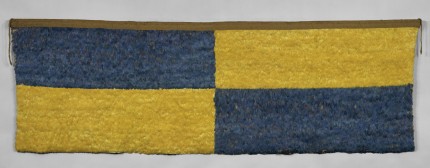
Peru; reportedly from Corral Redondo, Churunga Valley
Wari; 7th-10th century
Feathers on cotton, camelid fiber, 29 1/4 x 83 5/8 in.
The Metropolitan Museum of Art, The Michael C. Rockefeller Memorial Collection, Bequest of Nelson A. Rockefeller, 1979
 Seven-year-old Koen Ergle found a dugout canoe that could be hundreds, even thousands of years old, while taking scuba diving lessons with his grandfather in Owen Lake in the Ocala National Forest east of Ocala, Florida. Former Marion County sheriff Ken Ergle and his grandson Koen were scuba diving in eight feet of water when Koen saw a piece of dark wood. His grandfather dismissed it as scrap from an old dock, but the boy insisted they investigate.
Seven-year-old Koen Ergle found a dugout canoe that could be hundreds, even thousands of years old, while taking scuba diving lessons with his grandfather in Owen Lake in the Ocala National Forest east of Ocala, Florida. Former Marion County sheriff Ken Ergle and his grandson Koen were scuba diving in eight feet of water when Koen saw a piece of dark wood. His grandfather dismissed it as scrap from an old dock, but the boy insisted they investigate.Koen said it looked like a canoe.
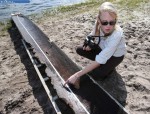 Julia Byrd photographed the canoe, took detailed measurements and samples. The samples will be analyzed to determine which wood the canoe is made out of and to radiocarbon date it. Native Americans lived in the area starting 15,000 years ago, so the canoe could be pre-historic or from more recent history. A shard of Native American pottery was discovered near the canoe and it’s in a style dating back 2,000 years, but that could be a coincidence.
Julia Byrd photographed the canoe, took detailed measurements and samples. The samples will be analyzed to determine which wood the canoe is made out of and to radiocarbon date it. Native Americans lived in the area starting 15,000 years ago, so the canoe could be pre-historic or from more recent history. A shard of Native American pottery was discovered near the canoe and it’s in a style dating back 2,000 years, but that could be a coincidence. 
